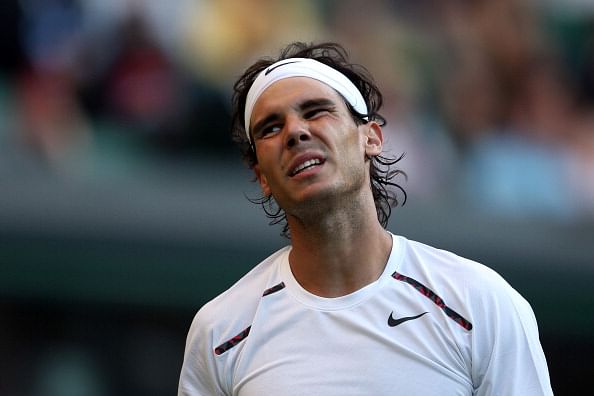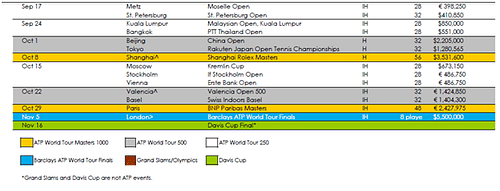
The 'Fall' of tennis
 When was the last time you tuned in to watch a tennis match that was not in a Grand Slam? How many of you have looked at David Ferrer‘s ranking and wondered how it is so high? The answers to these questions, however complicated they might be, eventually boil down to one thing – the ATP calendar. The scheduling of tournaments is done by the governing body of men’s professional tennis, and if Nadal and Murray’s constant complaints are any indication, they are not doing a very good job of it.
When was the last time you tuned in to watch a tennis match that was not in a Grand Slam? How many of you have looked at David Ferrer‘s ranking and wondered how it is so high? The answers to these questions, however complicated they might be, eventually boil down to one thing – the ATP calendar. The scheduling of tournaments is done by the governing body of men’s professional tennis, and if Nadal and Murray’s constant complaints are any indication, they are not doing a very good job of it.
The year round calendar consists of a multitude of events – ATP Masters 1000, ATP Masters 500, ATP World Tour 250, the four Grand Slams (these are not governed by the ATP), Davis Cup, Hopman Cup and of course the World Tour Finals. Unfortunately or fortunately, its the Grand Slams that hog all the limelight, while sometimes, even the Masters events do not get enough media coverage. The viewer’s interest is at a peak during the Grand Slams, and once curtains close on the last Slam of the year – the US Open, many people simply switch off their tennis brains. This happens in mid-September. There are two whole months of non-stop tennis that happens after this, and yet, very rarely do all the top players participate in an event. This is typically called the ‘Fall Season’ of tennis, and it lasts from Sep 21st to Dec 21st. Here is a schedule of the events that happen during this period.

Fall Season Schedule.
Of the 9 tournaments in the fall season, there are 2 ATP Masters 1000 and one World Tour Final. The remaining 6 tourneys do not attract the top players, and more often than not, these tournaments help the slightly lower ranked players to clock up points and improve their rankings for the coming season. Given how long and grueling the tennis season is, fatigue and a certain level of disinterest also sets in, for both the player and the viewer. Injuries and illnesses start becoming more evident, and pull outs or withdrawals have become a common occurrence at these events. Contrast this with the women’s Tour, and one sees that the WTA seems to be doing a much better job in terms of planning the events. The women’s Tour has 8 tournaments in the fall season, with the last one ending in mid October, which gives the players a good 8-9 weeks of ‘rest’. For the men, if their team is in the Davis Cup finals, the season can extend up to late November, leaving them with effectively 4-5 weeks of off-season. No wonder then that there is widespread criticism from several players.
The President of the ATP World tour finally gave a statement regarding this issue in late 2010. He said, “Our 2012 and 2013 calendars each provide for the seven-week off season, meaning that our players will have an additional two weeks to spend, away from the rigours of life on tour, before taking up the cause again the following year.” Sounds good on paper, but has the ATP managed to achieve this? They have not cancelled any event. Nor have they changed the status of any event. They have achieved this by pushing four late season events to the start of the season in the following year, and by striking off the one week holiday between the Paris Masters and the World Tour Finals. Just imagine, if a player makes it to the finals of the former, he will have to play the match, get on a plane, reach London and start prepping for the World Tour Finals. There is no breathing space.
Another point of contention here is the high number of indoor hard court events. With a massive increase in the number of HC events on the calendar, several top players have voiced disappointment. For instance, Nadal, known for his physical brilliance said, “Hard courts are very negative for the body. I may have to play more on clay than before, but there aren’t that many options.” Critics might argue that it is Nadal’s style of play that is affecting his condition more than anything else, but the bottom line is, tennis is a very demanding sport now. A staggering number of matches have gone to 5 sets and crossed the four-five hour time limits. Hard courts in particular have witnessed great tussles of might and spirit. In lieu of all this, would it not make sense to shorten the season, reduce the number of indoor hard court events, and give the players more room to recuperate? This would be in the larger interest of tennis.

Grand Slams Schedule
A few other possible solutions could be:
1) Rescheduling the Grand Slams in such a way that there is equal gap between the four. For instance, we have a 4 month long clay season but then just two grass court tournaments- Queens and Halle before Wimbledon. Why the step treatment to grass? Also, the US Open ends in the second week of September while the players go on to play till mid-November. Lack of motivation and tiredness is bound to come into play.
2) Instead of bundling up all the indoor events towards the end, include a few of them during the start or the middle of the year.
3) Make a certain number of ATP 1000 or ATP 500 events compulsory for every player in a year.
4) Give the Davis cup a much needed boost by not scheduling it at the end of the year when people and player interest is at a low.
5) The most obvious solution – increase the off season. Give the players a longer break, or perhaps, push back the Australian Open by a week so that there are a few more high profile events preceding it.
To sum it all up, tennis is experiencing its golden era now. The popularity of the sport and the players is at an all time high. This gives the ATP even more incentive to be careful with the scheduling, so that the superstars of the sport do not end up being injured or disenchanted with the proceedings. The ball is literally in their court now!